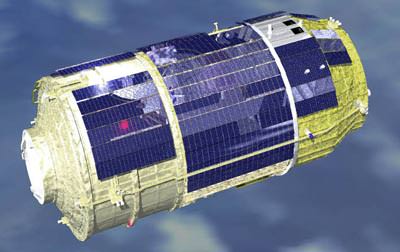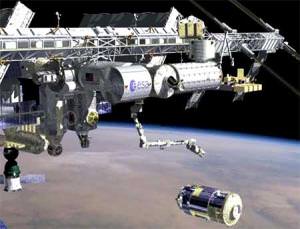Japan successfully launched its first re-supply spacecraft to the International Space Station today. After liftoff at 17:01 GMT (12:01 CDT) from Tanegashima Space Center in southern Japan, flight controllers confirmed the HTV-1 spacecraft separated from the H-2B rocket and now is in its preliminary orbit. The flight profile has the HTV taking seven days to reach the ISS so controllers can run various tests and demonstrations on its maiden voyage before rendezvousing with the space station. Unlike previous re-supply ships that dock directly to the station, the HTV will fly to within 10 meters from the ISS on September 17, and then astronaut Nicole Stott will reach out and grapple the spacecraft with the space station’s robotic arm, Canadarm 2, and connect it to the Harmony module on the ISS.
[/caption]
The new HTV spacecraft is the latest in an international fleet of cargo ships to support the space station. While capable of carrying 6.5 tons of cargo, on this first flight it is bringing up 5 tons of food, experiments and other supplies for the ISS. Unlike previous supply ships, it can haul large unpressurized experiments and equipment to remain outside the station, as well as supplies for inside the station, too. For its flight debut, the HTV-1’s external cargo drawer is filled with two experiments – one for JAXA and one for NASA – to be attached to the Kibo lab’s external porch.
The HTV weighs about 16 tons, is 9 meters (30 feet) long and 4.2 meters (14.5 feet) in diameter.

Another difference is that craft doesn’t have solar array wings, but has 57 solar arrays molded around the spacecraft to gather power from sunlight.
“HTV-1 is opening up new horizons for JAXA’s undertaking of human spaceflight,” said Masazumi Miyake, deputy director of JAXA’s Houston office. “I like to say that JAXA is now entering a new era.”
The success of both the HTV and the H-2B rocket will likely prove to be an important stepping stone for JAXA, as the country has ambitions of heading to the moon and Mars.


Very cool!
“Unlike previous re-supply ships that dock directly to the station, the HTV will fly to within 10 meters from the ISS on September 17, and then astronaut Nicole Stott will grapple the spacecraft with the space station’s robotic arm, and connect it to the Harmony module on the ISS.”
I like your blog, I really do. Your articles are informative and well thought out and researched. Which is why the following was such a shock and so disappointing.
As a Canadian I am a bit troubled about your usage of the words “robotic arm”. It is the Canadarm2, not the robotic arm. Media and nearly everyone else in the US seem to do this to us. Even the Canadarm succumbed to this renaming after it was placed on the Space Shuttle, which is now also referred to as the “robotic arm”. Please use the actual name of the device from here on as you seem to be able to do so with every other tech device. Perhaps once this could be passed off as an oversight, but twice is now a pattern. The Canadian-made robotic arms (Canadarm and Canadarm2) were efforts that Canada is just as proud of as Americans are of their space shuttle and everything else in your space program. It is only fair that the same respect is given to Canadian researchers and technology developers for all the effort they put into the development of these wonderful tools.
Thank you.
Roen- You are right. I’ve added the real name of the device to the article and will try to be diligent about using the proper names for them in the future.
Here here Roen!
Thanks, Nancy! 🙂